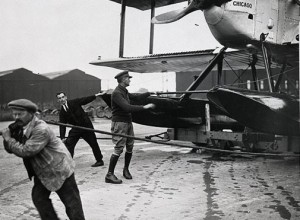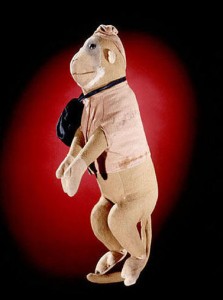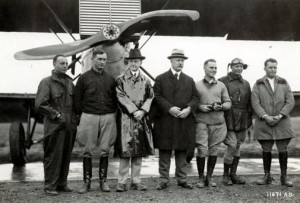Magellans of the Air
On September 28, 1924, crowds cheered and sirens shrieked as the Army Service pilots known as “the Magellans of the Air” landed at Sand Point Field in Seattle, Washington, after completing the first round-the-world flight.They had set off on April 6, some six months earlier, determined to circumnav…

On September 28, 1924, crowds cheered and sirens shrieked as the Army Service pilots known as "the Magellans of the Air" landed at Sand Point Field in Seattle, Washington, after completing the first round-the-world flight.
They had set off on April 6, some six months earlier, determined to circumnavigate the globe: eight men, four airplanes, eight stuffed spider monkeys from the Ambassador Hotel (see photo), and one stowaway from the Associated Press. (Ok, the AP stringer didn't climb aboard until the group reached India.)
The group endured Arctic snow (dodging icebergs because of low cloud cover), survived the blistering heat of India, and made their way through thick fogs and violent storms. The four ships—the Seattle, the Chicago, the Boston, and the New Orleans—were specially built by the Douglas Aircraft Company. Not all would complete the journey: The Seattle crashed in the fog on an Alaskan mountainside, and the Boston sank near Iceland. (The crews survived.)

The Chicago, part of the National Air and Space Museum's collections, is on display in the newly reopened Pioneers of Flight gallery. Jeremy Kinney, a curator in the aeronautics division, talked about the Chicago in a public presentation at the Museum this week. "The Army Air Service aviators saw the purpose of this flight," he said, "as a key not only for stating their own importance within the defense establishment in the United States, but also as a way to make the world better, to show the ability of the airplane as a global technology."
The 26,345-mile flight transfixed the world: couples arranged their marriages to coincide with the termination of the World Flight; babies were named after the pilots; the fashion-minded wore patches cut in the silhouette of a Douglas Cruiser. To learn more, read the 1925 book The First World Flight, based on the crew's personal narratives, written by Lowell Thomas.

Or watch video of the flight from the National Archives.